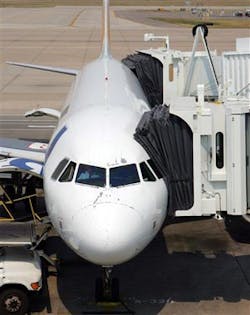United Introduces New Boarding Equipment
Looking to improve its boarding process and turnaround times, United Airlines is rolling out new automated boarding equipment that it says should make getting on and off its planes much faster.
The carrier put the first of five advanced jet bridges in place Thursday at Denver International Airport, one of its five U.S. hubs, with plans to install them at other airports in "the near future."
The dual-end or Y-shaped bridge connects to both doors of a narrow-body plane, arching over the wing to the back door, to allow for simultaneous loading or unloading. They automatically connect to aircraft using sensors that detect the plane's position, thus doing away with the need for workers to connect them by hand.
Some dual-end bridges are in use but United says its is the first to be completely automated.
The airline began testing the first bridge on Aug. 23 at Denver, where it is now fully operational for flights on Ted, its discount carrier.
"Our customers - especially those in the rear of the plane - are already telling us they love the convenience of the new bridges," said Alex Marren, United's vice president of operational services, United Express and Ted. "Also, because we can board customers faster, we are able to eventually add more flights without adding new aircraft."
United says the bridge can reduce the time it takes to unload and then reboard a plane, by 10 minutes, allowing it to fly its planes longer each day.
The carrier plans to install the other four in Denver by year's end and will look to expand to other airports soon afterward, spokeswoman Megan McCarthy said. She declined to elaborate.
United, a unit of Elk Grove Village, Ill.-based UAL Corp., is not disclosing the cost of the new bridges but has referred to them as "a multimillion-dollar asset." They are made by Ontario, Canada-based Dewbridge Airport Systems.
David Stempler, president of the Air Travelers Association consumer group, said anything that makes the boarding and exiting process go quicker will please passengers.
"The automated part should also eliminate those irritating waits when you sit there at your destination and have to wait for someone to come operate the jet bridge," he said.
But industry consultant Michael Boyd questioned the need for such an expensive system, saying airlines have at least 40 minutes to turn around their planes in a hub-and-spoke system anyway.
"It's a nice idea to get people on and off quicker," and it will help if flights are late, said Boyd, president of the Boyd Group in Evergreen, Colo. "But if you don't really need to do it, why are you putting all that money into it? This isn't going to suddenly make them more competitive than somebody else."
Stempler agreed that the service feature isn't likely to be a big factor in passengers' decisions about which flights to book, which he said are based primarily on price, schedule and frequent-flier relationships.
UAL, which emerged from three years in bankruptcy in February, reported its first true profit in six years in the second quarter, a $119 million gain. But it hasn't had a profitable year since 2000.
News stories provided by third parties are not edited by "Site Publication" staff. For suggestions and comments, please click the Contact link at the bottom of this page.

